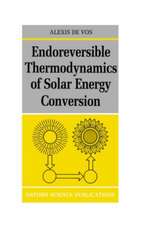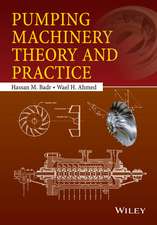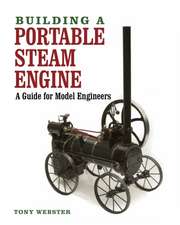Modelling Diesel Combustion: Mechanical Engineering Series
Autor P. A. Lakshminarayanan Contribuţii de Yu Shi Autor Yoghesh V. Aghav Contribuţii de Rolf D. Reitzen Limba Engleză Paperback – 5 mai 2012
| Toate formatele și edițiile | Preț | Express |
|---|---|---|
| Paperback (1) | 945.62 lei 6-8 săpt. | |
| SPRINGER NETHERLANDS – 5 mai 2012 | 945.62 lei 6-8 săpt. | |
| Hardback (1) | 951.77 lei 6-8 săpt. | |
| SPRINGER NETHERLANDS – 29 mar 2010 | 951.77 lei 6-8 săpt. |
Din seria Mechanical Engineering Series
-
 Preț: 391.84 lei
Preț: 391.84 lei - 18%
 Preț: 1110.72 lei
Preț: 1110.72 lei - 15%
 Preț: 593.73 lei
Preț: 593.73 lei - 18%
 Preț: 944.99 lei
Preț: 944.99 lei - 15%
 Preț: 653.14 lei
Preț: 653.14 lei - 17%
 Preț: 363.12 lei
Preț: 363.12 lei - 18%
 Preț: 1239.05 lei
Preț: 1239.05 lei - 15%
 Preț: 640.06 lei
Preț: 640.06 lei - 18%
 Preț: 1129.65 lei
Preț: 1129.65 lei - 15%
 Preț: 522.24 lei
Preț: 522.24 lei - 15%
 Preț: 654.77 lei
Preț: 654.77 lei - 15%
 Preț: 643.34 lei
Preț: 643.34 lei - 15%
 Preț: 611.40 lei
Preț: 611.40 lei - 18%
 Preț: 765.96 lei
Preț: 765.96 lei - 20%
 Preț: 631.70 lei
Preț: 631.70 lei - 18%
 Preț: 1009.22 lei
Preț: 1009.22 lei -
 Preț: 418.34 lei
Preț: 418.34 lei - 15%
 Preț: 640.71 lei
Preț: 640.71 lei -
 Preț: 403.53 lei
Preț: 403.53 lei - 18%
 Preț: 813.97 lei
Preț: 813.97 lei - 18%
 Preț: 1386.48 lei
Preț: 1386.48 lei - 18%
 Preț: 951.47 lei
Preț: 951.47 lei - 18%
 Preț: 833.09 lei
Preț: 833.09 lei - 18%
 Preț: 942.01 lei
Preț: 942.01 lei - 15%
 Preț: 644.49 lei
Preț: 644.49 lei - 18%
 Preț: 941.05 lei
Preț: 941.05 lei - 18%
 Preț: 1386.17 lei
Preț: 1386.17 lei -
 Preț: 399.67 lei
Preț: 399.67 lei - 18%
 Preț: 1394.84 lei
Preț: 1394.84 lei - 18%
 Preț: 790.46 lei
Preț: 790.46 lei - 18%
 Preț: 1388.22 lei
Preț: 1388.22 lei - 18%
 Preț: 1024.53 lei
Preț: 1024.53 lei - 15%
 Preț: 590.16 lei
Preț: 590.16 lei - 18%
 Preț: 1234.00 lei
Preț: 1234.00 lei - 18%
 Preț: 1386.62 lei
Preț: 1386.62 lei - 15%
 Preț: 543.85 lei
Preț: 543.85 lei -
 Preț: 391.61 lei
Preț: 391.61 lei - 18%
 Preț: 944.19 lei
Preț: 944.19 lei - 18%
 Preț: 736.16 lei
Preț: 736.16 lei - 18%
 Preț: 943.88 lei
Preț: 943.88 lei - 15%
 Preț: 693.21 lei
Preț: 693.21 lei - 18%
 Preț: 781.77 lei
Preț: 781.77 lei - 15%
 Preț: 639.08 lei
Preț: 639.08 lei - 23%
 Preț: 737.28 lei
Preț: 737.28 lei - 15%
 Preț: 641.53 lei
Preț: 641.53 lei -
 Preț: 401.42 lei
Preț: 401.42 lei
Preț: 945.62 lei
Preț vechi: 1153.19 lei
-18% Nou
Puncte Express: 1418
Preț estimativ în valută:
180.97€ • 186.95$ • 150.61£
180.97€ • 186.95$ • 150.61£
Carte tipărită la comandă
Livrare economică 25 martie-08 aprilie
Preluare comenzi: 021 569.72.76
Specificații
ISBN-13: 9789400731868
ISBN-10: 9400731868
Pagini: 320
Ilustrații: XIII, 305 p.
Dimensiuni: 155 x 235 x 17 mm
Greutate: 0.45 kg
Ediția:2010
Editura: SPRINGER NETHERLANDS
Colecția Springer
Seria Mechanical Engineering Series
Locul publicării:Dordrecht, Netherlands
ISBN-10: 9400731868
Pagini: 320
Ilustrații: XIII, 305 p.
Dimensiuni: 155 x 235 x 17 mm
Greutate: 0.45 kg
Ediția:2010
Editura: SPRINGER NETHERLANDS
Colecția Springer
Seria Mechanical Engineering Series
Locul publicării:Dordrecht, Netherlands
Public țintă
ResearchCuprins
Phenomenology of Diesel Combustion and Modelling.- Experiments.- Turbulent Structure of the Diesel Spray.- Ignition Delay in a Diesel Engine.- Heat Transfer.- Heat Release in Indirect Injection Engines.- Mixing Correlations for Smoke and Fuel Consumption of Direct Injection Engines.- Heat Release in Direct Injection Engines.- Hydrocarbons from DI Diesel Engines.- Hydrocarbon Emissions from Spark Ignition Engines.- Smoke from DI Diesel Engines.- Oxides of Nitrogen from Direct Injection Diesel Engines.- Particulate Matter from Direct Injection Diesel Engines.- Multi-dimensional Modelling of Diesel Combustion: Review.- Multi-dimensional Modelling of Diesel Combustion: Applications.
Textul de pe ultima copertă
The diesel engine is the most efficient combustion engine today and it plays an important role in transport of goods and passengers by land and sea. However, the emissions must be controlled without sacrificing the legendary fuel economy of the diesel engines. These important drivers have caused innovations in diesel engineering like re-entrant combustion chambers in the piston, lower swirl support and high pressure injection, in turn reducing the ignition delay and hence the nitric oxides.
This book is a detailed discussion of diesel combustion phenomena like ignition delay, fuel air mixing, rate of heat release, and emissions of smoke, particulate and nitric oxide. It enables quantitative evaluation of these important phenomena and parameters. Most importantly, it attempts to model them with constants that are independent of engine types.
This work recognises the importance of the spray at the wall in precisely describing the heat release and emissions for most of the engines on and off road. It gives models for heat release and emissions. Every model is thoroughly validated by detailed experiments using a broad range of engines. Throughout the book, the models use constants that are independent of engine type or design and hence they could be applied by the designer and researcher for a general engine. All the models not only describe the trends of important parameters but also quantitatively close to the experimentally observed results.
The enhanced understanding of the phenomena like turbulent flows, high-pressure sprays naturally converges to quantitative prediction using multi-dimensional CFD tools to reveal finer details of in-cylinder processes of diesel combustion. The CFD tools are introduced with case studies in two chapters of the book to help study innovative combustion concepts and improve engine designs in terms of emissions reduction and fuel economy.
This book is a detailed discussion of diesel combustion phenomena like ignition delay, fuel air mixing, rate of heat release, and emissions of smoke, particulate and nitric oxide. It enables quantitative evaluation of these important phenomena and parameters. Most importantly, it attempts to model them with constants that are independent of engine types.
This work recognises the importance of the spray at the wall in precisely describing the heat release and emissions for most of the engines on and off road. It gives models for heat release and emissions. Every model is thoroughly validated by detailed experiments using a broad range of engines. Throughout the book, the models use constants that are independent of engine type or design and hence they could be applied by the designer and researcher for a general engine. All the models not only describe the trends of important parameters but also quantitatively close to the experimentally observed results.
The enhanced understanding of the phenomena like turbulent flows, high-pressure sprays naturally converges to quantitative prediction using multi-dimensional CFD tools to reveal finer details of in-cylinder processes of diesel combustion. The CFD tools are introduced with case studies in two chapters of the book to help study innovative combustion concepts and improve engine designs in terms of emissions reduction and fuel economy.
Caracteristici
This work recognizes the importance of the spray at the wall in precisely describing the heat release and emissions for most of the engines on and off road The work considers findings of the peers and adds the fruits of the authors’ research to arrive at the improved description of important phenomena. Later, it models the heat release and emissions Every model is thoroughly validated by detailed experiments Throughout the book, the models use constants that are independent of engine type or design and hence they could be applied by the designer and researcher for a general engine All the models not only describe the trends of important parameters but also quantitatively close to the experimentally observed results These facts distinguish the book from others and make it unique Includes supplementary material: sn.pub/extras











